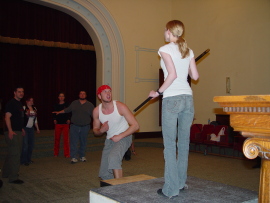 The latest undertaking by the Quad Cities' classical-drama troupe the Prenzie Players is an adaptation of Spanish playwright Pedro Calderón de la Barca's Life's a Dream, and at one point during a recent interview, group co-founder and Dream director J.C. Luxton tells me, "This show is just running, running, running. There aren't a lot of breaks for anybody."
The latest undertaking by the Quad Cities' classical-drama troupe the Prenzie Players is an adaptation of Spanish playwright Pedro Calderón de la Barca's Life's a Dream, and at one point during a recent interview, group co-founder and Dream director J.C. Luxton tells me, "This show is just running, running, running. There aren't a lot of breaks for anybody."
Including, as it turns out, the audience.
Currently wrapping up their sixth season of local performances, the Prenzies have staged a dozen Shakespeare plays since March of 2003, and are known for their surprises: gender-blind casting, anachronistic language and props, the occasional sing-along.
Yet beyond being the first non-Shakespeare title the Prenzies will have produced, Life's a Dream - premiering at Rock Island's Masonic Temple on May 9 (and co-starring Reader employee Stephanie Burrough and Reader intern Jeff De Leon) - might surprise even those familiar with the group's inventive output, at least if they expect to remain seated during the presentation.
Audiences will find themselves literally following characters from one scene - and one playing area - to another, and Luxton emphasizes that "this will, in fact, happen three times during the performance. Everybody's gonna get up, leave their seats, move into a whole 'nother space, and the play will resume."
Which isn't to say that the production will ever stop, either, as the Prenzies have added another unanticipated element to their latest offering - a supporting ensemble that, during the play's two act breaks, will continue the drama through improvised encounters occurring throughout the Masonic Temple.
Life's a Dream co-star (and fellow Prenzie co-founder) Denise Yoder stresses that "you have to make sure you're paying attention when there are intermissions, because things are going on in stairwells, you'll see characters out in the hallway, you'll hear things ... ."
"Just because there's an intermission doesn't mean you can escape," adds Luxton with a laugh. "The show is continuing downstairs, and out where they're selling concessions, and on the stage area."
So, I ask, if I use the men's room during one of the breaks, I'll be missing out on improvised scenes?
Luxton grins. "Except for the one in the men's room."
Out of Cool Left Field
 The idea to deviate from the Prenzies' Shakespeare-centric norm, Luxton says, was something the group "always kind of kicked around," as their Web site states their mission as being "to produce serious verse theatre using financially modest production," Bard or no Bard. "So we talked about Marlowe, and Webster, and Ben Johnson got mentioned ... ."
The idea to deviate from the Prenzies' Shakespeare-centric norm, Luxton says, was something the group "always kind of kicked around," as their Web site states their mission as being "to produce serious verse theatre using financially modest production," Bard or no Bard. "So we talked about Marlowe, and Webster, and Ben Johnson got mentioned ... ."
"We'd thrown around options," adds Yoder. "Though not necessarily a Spanish one, which is kind of out of left field. But out of cool left field."
Having seen a production of Calderón's 1636 play in Iowa City, Luxton says, "I think I was the one who brought up Life's a Dream, because," he adds with a laugh, "it's a very J.C. show. The audience is in a constant state of ambiguity as to whether it's a comedy or a tragedy, and those are the shows I like best - the ones where you're, like, 'Will this turn out well? Will this turn out bad?'"
Certainly, in the Calderón piece, things don't start well.
Offering a bare-bones synopsis of the plot, Luxton begins, "Twenty years before the play opens, the king of Poland, who is a renowned astrologer and diviner of fate, receives bad omens about the birth of his son - that the kingdom is eventually going to be divided and partitioned, and his son is going to use his head as a carpet. So he's really freaked out by this.
"His wife, the queen, dies in childbirth, and for the king, it's a confirmation that everything horrible that was prophesied about his son is gonna come to pass. So he sends word through the kingdom that his son was stillborn, and he imprisons him in a tower in the mountains, where he's raised like an animal; the kid, Sigismund, doesn't know he's a prince, and his guards don't know he's a prince, and most of his 'education' comes from watching animals on the mountainside."
Yet as the prince grows into adulthood, the king realizes that his kingdom will soon be without an heir, "and he decides to do an experiment," continues Luxton. "He says, 'Well, what if we drug Sigismund, and we put him on the throne, and when he wakes up we tell him the truth - that he's really the prince? If he rules well, he'll be the king. And if he rules poorly, we'll drug him again, throw him back in the tower, and tell him it was all a dream.'"
Calderón's seriocomic verse drama, the best known of roughly 70 works by the author, was deemed an ideal fit for the Prenzies in regard to style, subject, and degree of performance difficulty; Eddie Staver III, who assumes the demanding role of Sigismund, states, "I knew it was gonna be hard, but I didn't know what it would take to act just 10 minutes of that physical output and those speeches ... . J.C.'s been telling me that by the end of the show I'm gonna be laying on the ground just dead tired, and I'm starting to think he might be right."
But with numerous translations of the poetic classic to choose from (including Michael Kidd's acclaimed 2004 prose translation), finding an ideal English-language version of Life's a Dream proved vexing. In the end, Luxton - who has been responsible for adapting most of the Prenzies' presentations - instead chose to combine passages of dialogue from five different sources.
"There were pieces that were good in all of them," Luxton says of the translations, "but none of them were as powerful as I thought they could've been. So I spent, like, three months merging them line by friggin' line, which is harder than you might think because, for the most part, it's not blank verse - it's iambic tetrameter, four beats per line, and these really complicated patterns.
"But hopefully," he adds, "you won't notice [the editing] at all."
"You totally won't," affirms Yoder, adding that, initially, she and her fellow actors assuredly did.
"When he first sent the script to us," she says of Luxton's adaptation, "he literally had it color-coded from where he had gotten the translation. You would look at the script and you would see red and you would see orange ... whole stanzas, or even a couple of lines, would be in different colors. But he ended up creating something that's just beautiful."
With Life's a Dream, however, Luxton wanted not only to provide a unique Calderón translation, but a unique theatrical experience.
"For quite a while now," he says, "I've been dying to actually use two different theatre spaces [for one show], and to move the audience between them.
"This isn't like an original idea," he continues. "I've been to many plays in Iowa City where the audience moves. But since we're using the Masonic Temple, which has all these rooms ... .
"I mean, I like shows where I get to get up and move around and stuff. It's maybe not a universal pleasure," Luxton concedes with a laugh, "but I love it."
Not-So-Invisible Spectators
 "It's partly my fault," says Yoder of the decision to take audiences on both a figurative and literal journey in Life's a Dream.
"It's partly my fault," says Yoder of the decision to take audiences on both a figurative and literal journey in Life's a Dream.
The show's playing area had to be large enough to suggest the grandeur of the production's palace sequences, yet with certain scenes taking place within the confines of Sigismund's prison, the Masonic Temple's sizable upstairs and downstairs halls (where the Prenzies have presented all of their works since the spring of 2006) presented obstacles.
"J.C. was saying, 'We need to make it claustrophobic,'" recalls Yoder. "'Can we move the show into any of the other rooms? Can we get X number of seats in there?'"
It was clear that what was needed wasn't one all-purpose space but two separate ones, and with one of the temple's halls equipped with its own proscenium stage, the solution became obvious. "There was this great area behind the curtain," says Yoder, "and I said, 'What if we made [the prison] back here?' And it just worked. And then it became, 'Can we make the move work within the context of the script?' And it does."
Subsequently, says Luxton, "We have a palace, which is bright and friendly, and the seats are relatively comfortable for a Prenzie show, and then we have the prison tower, which is dark and unpleasant, and very close and claustrophobic."
(As the Prenzies' previous endeavors have found the actors performing amongst the audience members, Luxton laughs, "It's actually our first show on a stage. Of course, the entire audience is on the stage. And the curtain's closed.")
The Prenzies acknowledge that this break from traditional stage convention is, as Luxton terms it, "a definite risk" for the group.
"It's absolutely something we discussed," adds Yoder of the traveling-audience concept. "You're going to find people who are not going to enjoy it. But it becomes one of those things where you're like, you know, why do you go to the theatre? Do you go because you're familiar with the play, and you know how it ends, and you like the way it's usually done, or do you want to be surprised?"
Regardless of preference, surprise is inevitably what attendees get. "We've had a lot of fun with our audiences," says Luxton. "I mean, there's nothing more complicated at Prenzie than the question of who the audience is from moment to moment. They might be invisible spectators that the actors are unaware of, or they might be confidantes whom the actors are suddenly talking to, or they might be members of a street crowd, or a bunch of nobles at a palace ... . You know, we're constantly shifting their identity."
Luxton says audiences should expect no less from Life's a Dream. "As they enter, they're soldiers under Captain Doloreta - military people. Then, once they sit down around Sigismund, they become the walls of the tower imprisoning him. They are actually what's preventing him from escaping; he's imprisoned by the spectators. And then, at the end of the first scene, the audience moves into the palace, where they're explicitly named nobles of the Polish court, and treated as such."
Yet while the collective role of the audience members will shift throughout the production, those of six Life's a Dream actors won't, as they'll be improvising exposition and dramatizing the story's effect on Calderón's kingdom even during the intermissions - a dramatic curlicue that's just one of several presentational elements making Luxton feel, as he says, "way out of my comfort zone as a director."
Enter the Beastmaster
 Prenzie productions typically feature small-scale ensembles - rarely more than a dozen performers, with most assuming more than one role - and it's a convention that Luxton says has less to do with a dearth of casting options than "about creating a community of actors" within the group.
Prenzie productions typically feature small-scale ensembles - rarely more than a dozen performers, with most assuming more than one role - and it's a convention that Luxton says has less to do with a dearth of casting options than "about creating a community of actors" within the group.
"I've been in so many shows where there's a huge cast," Luxton says, "and you have, like, a part in Act IV, and you sit there backstage, and you wait, and you come on, and then you're done, and all your energy goes pffft. From an actor's point of view, that's when you're not really part of a team. You're a person waiting to do your one thing. Your trick.
"With an ensemble," he says of the casting in Prenzie shows, "the last thing we wanted was to have, like, six spear-carriers standing in the background of scenes, trying not to sway because they're so bored. I mean, we could do a 25-person show; we could just cast like crazy and be like, 'Here's your one little part.' But we don't do that, because to us it's much more important that we have this tight-knit group that's all working together."
Consequently, for Life's a Dream, Luxton decided to expand the roles of six of the show's ensemble members - Yoder among them - by keeping them engrossed in the story even after the stage action has been temporarily halted.
"We interact with other characters on stage," explains Yoder, "but we are, essentially, the court militia, and we're there to give you an idea of what's going on in the court, and how things that are going on in prison are affecting the court."
"If I was gonna have people without many lines," says Luxton of his improvisational sextet, "I wanted to make sure that all six of them had definable parts, even if the audience wasn't aware of it."
Audiences can expect several other novelties, though, of which they no doubt will be aware. Among them is the first soundtrack written for a Prenzie production, composed by Terry Skaggs. "He calls it an audio landscape," says Luxton. "It's sort of similar to ambient music, where it's about a 30-minute sampling of sounds, music, beats. ... It's an outward reflection of Sigismund's consciousness. I actually had to track down a sound system that's worthy of the stuff Terry's doing."
In addition to aural experimentation, Life's a Dream allows the Prenzies the opportunity to experiment physically. "Language-wise," Luxton says, "we've always this wide range of stylization, but we pretty much only work with extraordinarily naturalistic movement. I suppose the fights are stylized to an extent, but we've never really played with that spectrum much at all, mainly because," he adds with a laugh, "none of us know anything about it."
Happily for Luxton, though, the group was able to secure the talents of those who did. Rockridge High School band director Jake Walker - a cast member in March's Taming of the Shrew who is referred to by the Prenzies, only half-jokingly, as "The Beastmaster" - was recruited to assist Staver in physicalizing the feral Sigismund.
"He's a genius with animals," says Staver of Walker. "Behaviors of animals, and what they do in defense, and how they act in certain situations - he'd take a little of this one and a little of that one, and find a way to make Sigismund's character an animal. His own animal."
And local performer Liz J. Millea added to the show a movement piece that, states Luxton, "some of the audience will see, if they're in the right place. The ensemble moves the drugged Sigismund into the palace during the first intermission, and what we're hoping the audience will experience is his dream of what's happening to him.
"We're doing a lot of new things," Luxton says of Life's a Dream, "but they're really just extensions of things we've been doing for years. It's just that I like to go, 'Okay, we've done this ... now let's go further. Let's belly-flop into the pool and find out how to swim.'"
That movement piece, though, does give you another reason not to leave your seat at intermission, I tell Luxton.
"But if you don't go," he replies, "you'll miss things."
For more information on Life's a Dream, running May 9 through 18 at Rock Island's Masonic Temple, visit (http://www.prenzieplayers.com).










